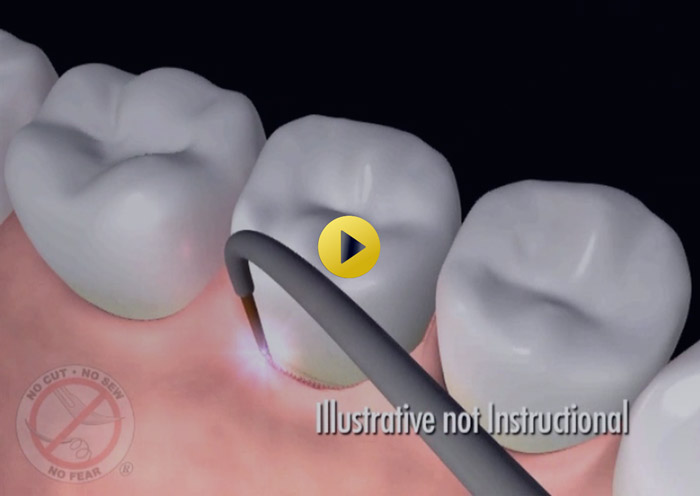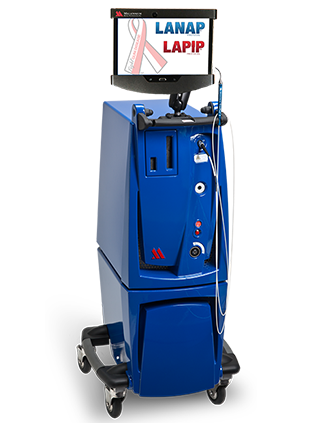Services
Laser Technology in Dentistry
PerioLase MVP-7 Dental Laser
- The PerioLase MPV-7 is the only dental laser specifically designed for better periodontal health. The unique wavelength targets the bacteria that causes gum disease for minimally invasive, highly effective, quick and painless treatment.
- Gum disease is a chronic inflammatory disease that destroys the tissue and bone around the teeth. If left untreated, the disease can lead to receding gums, loss of bone, and ultimately, tooth loss.
- Kills bacteria and disrupts biofilm to reduce inflammation
- Can help reverse gingivitis symptoms
- Maintain healthy gums and avoid progression of gum disease
- No shots needed
- No antibiotics needed, avoids antibiotic resistance
- The Iaser light can reach and destroy bacteria up to 6mm beyond the surface to help prevent bacteria from spreading back into the pocket.
- Safe for medically compromised patients, those on blood thinners, or those with diabetes
- Safe for use around crowns, bridges, sealants, and implants
- Beneficial to patients who have recently had surgery, or are scheduled to have surgery to reduce bacteria that may enter the bloodstream
LANAP Protocol featured on ABC News Now - Healthy Life
"A New Gum Disease Procedure"
Dr. Robert H. Gregg, developer of Laser Periodontal Therapy, discusses how scalpel-free dental laser therapy successfully treats the cause of gum disease (bacteria and resulting endotoxins) with less pain, less bleeding, less infection, and less recovery time. Airdate: May 6, 2008

How does the PerioLase Dental Laser Work?

LANAP & Gum Disease
LANAP Protocol
A Minimally-Invasive, FDA-Cleared Gum Disease Treatment with True Regeneration®
The patented LANAP protocol is a minimally-invasive surgical method of treating and often reversing gum disease.
During the procedure, the PerioLase MVP-7 dental laser is used to gently remove harmful germs and diseased tissue from the gum pocket, keeping healthy tissue intact.
The LANAP protocol is the only laser treatment to receive FDA clearance for True Periodontal Regeneration.
- New cementum
- New periodontal ligament
- New alveolar bone!
Overview of the LANAP Protocol
The image below illustrates the LANAP protocol steps:- o A. Periodontal probe indicates excessive pocket depth
- B. Laser light removes germs and diseased tissue
- C. Ultrasonic scaler removes root surface tartar
- D. Bone modification promotes new tissue growth
- E. Laser finishes cleaning pocket, stimulates growth factors, and aids in sealing the pocket closed
- F. Healing of gums to clean root surface occurs
- G. Bite trauma is adjusted
- H. Tissues and bone re-grow and healing occurs
The LANAP protocol can also help loose dental implants. Using the PerioLase MVP-7, we can often save ailing or failing implants using the LAPIP protocol. We use the same laser, but different laser settings and light exposure to help implants stabilize while destroying periodontal pathogens and endotoxins.
LAPIP & Implants
LAPIP Protocol
A Laser-Based Approach To Helping To Treat Ailing and Failing Dental Implants
Using the PerioLase MVP-7, we can often save ailing or failing implants using the LAPIP protocol.
We use the same laser, but different laser settings and light exposure to help your implant stabilize while destroying periodontal pathogens and endotoxins. The LAPIP protocol utilizes the unique PerioLase® MVP-7, a Nd:YAG free running pulsed laser requiring specific knowledge and skills derivative of the LANAP protocol.
This means the opportunity to protect your implant investment with no cutting, bone grafting or stitches. This means less pain, less bleeding, less swelling, less tissue removed, less down time, and less recovery time which is decidedly less costly to you and your employer.
The LAPIP protocol:
- Allows removal of diseased tissue without removing any of the healthy tissue
- Eliminates the infection
- Helps maintain the height of the tissue around implants,
- Minimizes pain and discomfort to the patient, and
- Closes the periodontal pocket wound to allow healing to take place.
- Perio probe indicates excessive pocket depth.
- Laser vaporizes bacteria, diseased tissue, pathologic proteins, and titanium corrosion contaminants in soft tissue.
- Ultrasonic scaler tips are used to remove surface accretions.
- Bone is modified at time of surgery.
- Laser is used to form a stable fibrin blood clot containing stem cells from bone.
- Adhesion to clean surface, with a stable fibrin clot at the gingival crest to create a ‘closed system’.
- Occlusal trauma is adjusted.
- New attachment is regenerated.

LPD & Inflammation
LPD & Inflammation
LPD kills bacteria and disrupts biofilm to reduce inflammation. The unique wavelength targets the bacteria that causes gum disease for minimally invasive, highly effective, quick and painless treatment. When isolated pocketing is present, LPD decreases pocket depths without curettage. Ideal for patients with gingivitis.
Benefits:- Quick and painless procedure to help maintain healthy gums and avoid progression of the disease
- Removes the inflammation so your body can heal naturally without antibiotics
- Safe for medically comprised patients, patients on blood thinners, and diabetic patients
- Kills bacteria and disrupts biofilm to reduce inflammation
- Can help reverse gingivitis symptoms
- Maintain healthy gums and avoid progression of gum disease
- No shots needed
- No antibiotics needed, avoids antibiotic resistance
- No known side-effects of LPD in over 25 years of therapy
- The Iaser light can reach and destroy bacteria up to 6mm beyond the surface to help prevent bacteria from spreading back into the pocket.
- Safe for medically compromised patients, those on blood thinners, or those with diabetes
- Safe for use around crowns, bridges, sealants, and implants
- Beneficial to patients who have recently had surgery, or are scheduled to have surgery to reduce bacteria that may enter the bloodstream
Laser Cavity Detection
More Treatments
More Treatments with the PerioLase MVP-7 Dental Laser
Biostimulation - Pain Reduction from TMJ and Orthodontics
Low Level Laser Therapy (LLLT) or biostimulation can be used for many applications within dentistry, in particular to reduce the pain associated with orthodontics or temporomandibular disorder (TMJ).
Benefits:- Eliminates pain associated with the aphthous ulcer
- Increases patient convenience by avoiding having to reschedule appointment because of pain from site
- For particular large ulcers, treatment can speed the healing process
Cold Sores - Herpetic Lesion (Viral Therapy)
Herpetic lesions can occur in three different forms: recurrent small blisters on the lips, a generalized oral infection, or small ulcers on the palatal mucosa. The most common form is small blisters on the lips, which can be treated with low level laser therapy. Outbreaks may be triggered by sunlight, physical trauma, stress, and other irritants. Lesions will usually resolve in 10-14 days, but may be painful.
Benefits:- Safe, quick, and comfortable treatment that relieves pain
- Immediate relief
- Lesions can be treated before a breakout if patients feel an “onset”
- Laser treatments can help reduce the number of cold sores and severity of future outbreaks
- For particular large ulcers, treatment can speed the healing process
- No anesthesia needed
Desensitization
Dental sensitivity affects more than 40% of adults worldwide, and more than 40 million people in the United States. [1] Exposed dental tubules are believed to be the predominate cause, with sensitivity to heat and cold the most common complaint. Laser therapy can help close tubules and reduces sensitivity. [1] Prevalence of dentine hypersensitivity in a general dental population. Irwin CR, P. Ir Dent Assoc. 1997; 43(1):7-9.
Benefits:- Relieves discomfort of sensitive teeth
- Can be performed before or after restorative treatments to increase patient comfort
